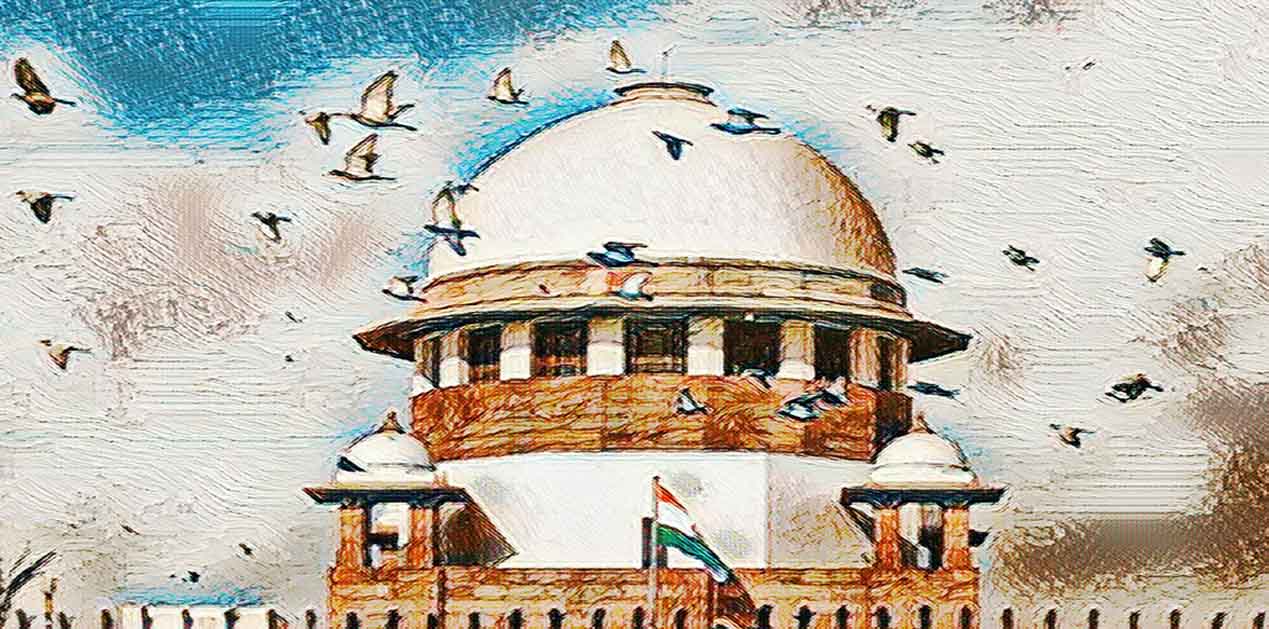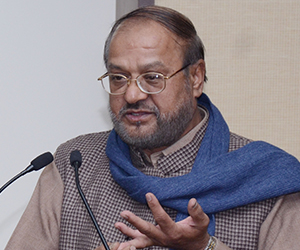After the Keshavanada Bharati and the A.D.M. Jabalpur Cases, High Courts and the Supreme Court of India came under immense pressure. The supersession of three senior most Supreme Court judges and promotion of judges of her choice in various High Courts and the Supreme Court of India was only the beginning; Mrs. Indira Gandhi resorted to punishing the judges whom she considered disobedient and inconvenient. In the first step she resorted to the forced transfer of judges from one High Court to another and that too from one corner of the country to another.
During the Emergency, on the pretext of achieving national integration, 16 High Court judges were transferred just in one go. These were the judges from nine High Courts who had previously given the judgments contrary to the Supreme Court in A.D.M Jabalpur Case. This mass transfer took place in 1976. These judges belonged to nine High Courts which had upheld the Fundamental Rights of persons detained during the Emergency. These judges were transferred for one corner of the country to another from their original high courts, without their consent and overriding their objections.1 Sixteen High Court judges, who were transferred, were not guilty of any misbehaviour or wrong-doing. On the contrary they had performed their constitutional duties with utmost sincerity, and had only delivered judgments which were not to the liking of the Government of the day. In his characteristic style, H.M. Seervai writes, “The sixteen judges were transferred not for doing anything wrong but for doing right to all manners of people according to the Constitution and the laws.”2 These judges had ruled that the detention of leaders like Morarji Desai, Atal Behari Vajpeyee, L.K. Advani, Madhu Dandvate, Shyam Nandan Mishra and many others under the MISA during the emergency was illegal.
In many cases, judges, initially appointed for two years’ probation before their confirmation in High Courts, were not continued because their judgments were not seen in favourable light by the Government. The intent of the Government was also reflected in its decision to prohibit all newspapers from publishing the names of the transferred judges or any discussion over it. A further threat to the judges was indicated by the Government by deliberately leaking the names of 40 High Court judges as being under consideration for transfer.3 This was the most blatant attempt to threaten and control the higher judiciary. During the emergency a large number of Additional Judges in various High Courts were denied routine extensions or confirmations. These judges were mostly those who had ruled against the unlawful detention of ordinary citizens during the Emergency. The list included Mr. R.N. Aggrawal, Additional Judge of Delhi High Court, who had ordered the release of Kuldip Nayar from preventive detention. In 1980, when Congress returned to power, five High Court Chief Justices were retired without being confirmed. Additional Judges were being given extensions or given appointments only at the last moments and were made to fill in several very demeaning undertakings.
The slur and insult was so much manifest in this act of transfer that two of the judges died of shock and heart attacks. The Government was criticised for this act but of no avail. A very suave and polished Justice M.C. Chagla, Mrs. Gandhi’s own former Education and Foreign Minister, was to describe this act of Mrs. Gandhi as, “The most brutal and inglorious period of our history.”4 He further said that all this could happen just because Chief Justice A.N. Ray was very weak and cowardice.5 For everything, the Chief Justice of India (CJI) waited for directions from Mrs. Gandhi or her colleagues.
Dealing with the transfer case during the Emergency and the Government’s pretext that this was a step towards innovative method of national integration, Justice Y.V. Chandrachud observed (indeed only after the end of Emergency and the defeat of Mrs. Gandhi) that, “There are numerous other ways of achieving national integration more effectively than by transferring High Court Judges from one High Court to another… Considering the great inconvenience, hardship and possibly a slur which a transfer from one High Court to another involves, the better view would be to leave the Judges untouched and take other measures to achieve that purpose. If at all, on mature and objective appraisal of the situation, it is still felt that there should be a fair sprinkling in the High Court judiciary of persons belonging to other States, that object can be more easily and effectively attained by making appointments of outsiders initially.”6
Congress Party leaders and the Government left no stones unturned to malign and demoralise the judges. A cabinet Minister of the Mrs. Gandhi’s Government had bracketed the entire judiciary with the opposition parties just because some judges would not accept and do what the Congress Government wanted. In the Lok Sabha, Law and Justice Minister H.R. Gokhale (who himself was a judge in Bombay High Court before joining politics), and other leaders like K.P. Unnikrishnan, Chandrajeet Yadav, P. Kumaramangalam and many others started talking about a ‘committed’ judiciary. Mr. H.R. Gokhale went as far as issuing a letter to each judge through the State Chief Ministers that, “The Government of India thinks very highly of those ‘value-packed’ judges who never rule against the Government, and will consider favorably their promotion to the Supreme Court.”7
Emergence of the Collegiums System
As we have already seen, the appointments in the High Courts and Supreme Court have always been an issue between the judiciary and executive right from the time of Jawaharlal Nehru, not based on merit but on personal likes and dislikes. But what happened during Mrs. Indira Gandhi’s rule, and especially during the Emergency, must have been a matter of great concern among the judges who valued and treasured the independence of the judiciary. Conduct of executives during the Emergency provided further impetus towards doing something to insulate higher judiciary form excessive interference of legislatures and the executives.
The roots of the collegium system is traced to the First Judges case 8 but it got a concrete shape from the Second and Third Judges Cases which were the Supreme Court Advocates on Account Case (judgment on 06.10.1993)9 and Government of India’s Petition for the Reconsideration of the Judgment of 6 October, 199310 respectively. The Collegiums came into existence immediately after the judgment in the Supreme Court Advocates on Account Case of 1993) 11. This judgment took the position that opinion of the CJI in agreement with two other senior most judges was to be read as concurrence. This judgment fundamentally altered the nature and process of appointments envisaged in Article 124(2) and Article 217(1) of the Constitution. In the entire Constitution there is no provision of Collegium for the appointment of High Courts and Supreme Court judges. In a way this judgement rewrote these Articles dealing with the appointments of High Courts and Supreme Court judges without deleting or subtracting these from the Constitution.
In the Second Judges Case, it was further held that in the event of disagreement between the constitutional functionaries involved in appointments of judges, the opinion of CJI will have primacy. In other words, the CJI usurped the constitutional powers of the President of India. In the beginning, the CJI consulted two of his senior most judges but it was expanded to four senior most judges through the Third Judges Case. Eventually, through the Third Judges Case, the Supreme Court laid down different sizes of Collegiums depending on whether it was for an appointment to the Supreme Court or the High Courts, or transfer of judges from one Court to another.
Since the Collegiums came into existence all appointments to the Supreme Court and High Courts have been done by it. However, discordant voices have been raised regarding the functioning of the Collegium. It has also come into question by the judges themselves. Not only there are no criteria or parameters that are followed for the appointments of judges but also no records of the Collegium meetings and details of judges who are appointed are kept. Neither are detailed or even brief procedures have been evolved for arriving at the decisions. In nutshell, the main points of dissatisfactions can be summarised as follows:-
- There are no parameters and no frameworks for the selection of High Court judges or elevation to the Supreme Court, and no minutes are kept in such matters;
- Everything is kept secret and no one knows anything beyond the Collegiums members;
- Nepotism reigns in the Collegium’s decisions;
- Time and again, Supreme Court judges, even some Chief Justices, have voiced that things were not well in the Collegium system and urgent reforms were needed.
In absence of any working procedure or framework everything has come down to personal likes and dislikes and indeed tough bargains are carried on not only among the Collegium members but also between the Collegium and the executives. Justice Ruma Paul, a retired Supreme Court judge and herself member of the Collegium for some time, says, “The process by which a judge is appointed to the High Court or elevated to the Supreme Court is one of the best kept secrets in the country…. The ‘mystique’ of the process, the small pool from which the selections were made and the ‘secrecy and confidentiality’ ensured that the process may, on occasions, make wrong appointments and, lend itself to nepotism.”12 Justice Chelameswar had been so frustrated that several times he had refused to participate in the Collegium meetings and wrote very critical letter about the whole process.
That the Collegium does not follow any set criteria is reflected in the decisions it has made in elevating High Court judges to Supreme Court. Some of the most renowned judges and the senior most among all the High Courts’ combined judges’ seniority list could not make it to the Supreme Court. But at the same time, many rather junior judges made it to the top court. When Ruma Paul was elevated to Supreme Court she was at No. 70 in order of High Courts judges’ seniority; Altmas Kabir was at No. 13; Amitav Roy at No. 35; V.N. Krishna at No. 33; S.H. Variava at No. 38 and so on. K.M. Joseph, recommended (and now elevated) for the Supreme Court was No. 42 in the overall seniority and No. 11 among the Chief Justices. This are just few samples. Similarly, since the Collegium system came in, some judges could make it to Supreme Court after serving 15 years in High Court (JJ Anand, Kirpal, Deepak Mishra); 14 years (JJ Bharucha, Lodha, Thakur); 13 years (Justice Khare, Sabbarwal, Dattu); whereas a few were lucky to climb up to the Supreme Court just after nine years in the High Court. Justice V.R. Krishna Ayyar was an exception to have moved to Supreme Court just after three years in High Court. Not necessarily the selection and recommendation of judges have gone wrong all the time but the examples of justices C.S. Karnan, P.D. Dinakaran, Saumitra Sen and even CJI K.G. Balakrishnan show how sometimes things can go horribly wrong.
Nepotism in the appointments of judges is another thing that has been talked about openly. There are, or have been, six judges who are the sons of former Supreme Court judges: P.N. Bhagwati, S.M. Fazal Ali, B.P. Singh, N. Santosh Hegde, B.N. Agrawal and D.Y Chandrachud. As K.M. Joseph makes it, the tally has gone up. Similarly, High Courts are also adorned by large number of sons and grandsons of former Supreme and High Court - for example, A.K. Mukharjee (s/o B.K. Mukharjee), D.K. Kapur (s/o J.L. Kapur), D.K. Mahajan (s/o of C.K. Mahajan, gs/o M.C. Mahajan), B.P. Singh and R.P. Singh (s/o and gs/o B.P. Sinha), A.N. Ray (s/o Ajit Nath Ray), Anil Dev Singh (s/o Jasvant Singh), R.P. Mishra (s/o R.B. Mishra), K.M. Joseph (s/o K.K. Mathew) and so on. Besides, there are a large number of judges whose family members have deep connections with the executives as well as judiciary who made, and continue to make, it to High Courts or Supreme Court. A sitting judge recently said that, “Competition to reach to Supreme Court is so tough that without a godfather it is impossible.”13
Fali S. Nariman laments: “If there is one important case decided by the Supreme Court of India in which I appeared and won, and which I have lived to regret is the decision that goes by the title -- Supreme Court Advocate-on-Record Association vs. Union of India. (1993, 4 SSC441: AIR1994SC 268).” 14 Nariman’s pain can be appreciated by the fact that the title of Chapter 16 discussing this episode is titled, “A Case I won – But Which I Would Prefer to Have Lost”. After narrating various omissions and commissions since the Collegium system began, Nariman writes: “All this will tell you why I have been so greatly disappointed after winning the Second Judges case. Today I can only express my extreme anguish at the current state of ground realities in the matters of appointment of judges.” 15
National Judicial Appointment Commission
In order to overcome the problems of collusiveness and the lack of transparency in the Collegium, the National Judicial Appointment Commission (NJAC) Bill was passed by the Parliament. It was envisaged that NJAC will be responsible for the appointment of Judges to High Courts and Supreme Court, transfer of judges from one High Court to another and other matters related to the judiciary. The NJAC consisted of six members: Chief Justice of India (Chairperson, ex officio), two other senior judges of the Supreme Court after the Chief Justice of India (ex officio), the Union Minister of Law and Justice (ex-officio), and two eminent persons. Further, the two eminent persons were to be nominated by a committee consisting of the Chief Justice of India, Prime Minister of India, and the Leader of Opposition in the Lok Sabha (or where there is no such Leader of Opposition, then, the Leader of single largest Opposition Party in Lok Sabha), provided that of the two eminent persons, one person would be from the Scheduled Castes or Scheduled Tribes, or Other Backward Castes (OBC), or minority communities, or a woman. The eminent persons were to be nominated for a period of three years and would not be eligible for re-nomination.
The NJAC Bill became part of the Constitution through the 99th Amendment. It may be pointed out that it was passed by both the houses of the Parliament with an unusual unanimity. It was passed in Lok Sabha with 369 members voting in favour and none voting against it. In Rajya Sabha, it was passed by 179 members voting in favour while one member abstained from voting. Thus, not a single vote was cast against the Bill in any of the two Houses. After it was ratified by 24 states, the bill was given assent by the President of India, Shri Pranab Mukherjee, on 31 December, 2014. The principal objective of the NJAC was to ensure transparency and equal participation of both executive and higher judiciary that could bring in proper checks and balances which was the need of hour. Desire of the people of India for the last 25 years for greater transparency in the matter of judicial appointments system could not be ignored.
Once it became the reality, it was felt that NJAC would usher in a new era in the appointment of judge in the Supreme and High Courts and there shall be enough transparency. But even before the NJAC could start functioning a writ was filed in the Supreme Court against the 99th Amendment. The writ was heard by a bench of five judges headed by Justice J.S. Khehar. Other Judges were J. Chelameswar, M.B. Lokur, Kurian Joseph, and A.K. Goel. It is an enigma that why the five-judge bench did not refer this constitutional issue to a larger bench, at least a larger one than the nine-judge bench in the Second and the Third Judges Case that created the Collegium system.
A request made by the Government of India to refer the matter to a bench larger than the one which heard the Second and Third Judges Cases, as the issue involved the constitutional amendments and the Collegium itself. This request was turned down on 12 May, 2015 and the five-judge bench continued to hear the case. By any simple logic one would expect that a tradition of Golak Nath Case followed by Keshavananda Case, both of which dealt with the Constitutional Amendments, would be continued. The Golak Nath Case was heard by an eleven-judge bench and subsequently Keshavananda Bharati Case by a thirteen-judge bench. But here an amendment of such a magnitude was heard by just five-judge bench, while the NJAC Act involved all the four cases – Golak Nath, Kehsavananda Bharati, Second Judges and Third Judges Cases. Jurists opine that the NJAC Case should have been heard by the full Constitution Bench, i.e. a bench of thirteen judges.
The five-judge bench continued to hear the case. It was decided on 16 October 2015 by a majority of four v. one. Four judges majority struck down the 99th Amendment in the name of judicial primacy in the appointments, judicial independence and the violation of the ‘basic structure’ of the Constitution. It further ordered the continuation of Collegium system. Justice Khehar writes: “I have independently arrived at the conclusion, that Clause (c) of Article 124A(1) is ultra-vires of the provisions of the Constitution, because of the inclusion of the Union Minister in-charge of Law and Justice as an ex officio Member of the NJAC. Clause (c) of article 124A(1), in my view impinges upon the principles of ‘independence of the judiciary’, as well as ‘separation of powers’. It has also been concluded by me, that Clause (d) of article 124A(1) which provides for the inclusion of two ‘eminent persons’ as members of NJAC is ultra vires the provisions of the Constitution for a variety of reasons. The same has been held violative of the “basic structure” of the Constitution.”16
This judgment invalidating the 99th Amendment has been very heavily criticized, even by former judges of the Supreme Court. It has been felt that in the NJAC Case judges have erred on two counts. Neither the constitutional texts nor the Constituent Assembly debates provide any hint, leave alone a provision, for judicial primacy in the appointment of judges, and further, the judgment does not explain as to how judicial primacy is a part of ‘basic structure’ of the Constitution? Secondly, the judicial primacy does not explain how this would promote the judicial independence? The third count can be the fact that no other country in the world has the provision where judges appoint judges. It is very surprising that although the Court held that the minister had no veto power, yet his mere presence on the NJAC undermined judicial independence.
Only Justice Chelameswar upheld the 99th Amendment and the validity of NJAC. Former Supreme Court judge K.T. Thomas writes: “The majority judgment in the NJAC Case administered a warning that even four judges are enough to strike down a law not palatable to the judges of Supreme Court, no matter that such amending law had the backing of the Parliament, was rectified by 20 states, and in essence, was symbolic of the will of the people manifested by their representatives in Parliament…. Interestingly, while striking down the 99th Amendment and nipping the bud the system of judicial appointments that it sought to establish, the bench in the NJAC Case did acknowledge the frailties of the Collegium system. The perils highlighted by Justice Joseph are almost a testimonial point to the nadir to which the Collegium system has plummeted over the years. Justice Joseph acknowledged the fact that the present collegium system lacks transparency, accountability, and objectivity and very serious allegations and many a time not unfounded too, have been raised that its approach has been highly subjective. Yet the learned judge joined his brothers in striking down the 99th Amendment.” 17
Now we are back to square one. It is well over two and a-half years, that nothing has been done on the part of the Supreme Court to resolve the matter except that from time to time it laments that the Government was not appointing judges. Despite the promise to improve upon the functioning of the Collegium system and bringing in more transparency, so far nothing has been done. All this is neither good for judicial process nor the for the prestige of honourable courts and the judges. Taking examples from around the world the Supreme Court must come forward with an acceptable solution.
References:
- Granuville Austine, 1999, Working A Democratic Constitution, p.344.
- H.M. Seervai, 1998, Constitutional Law of India, p. 2802.
- Ibid. p. 2803.
- M.C. Chagla, 1977, ‘Memorial Lecture’ delivered at Bombay House on 15 December 1977.
- See forward to M.C. Chagla, Roses in December, (Autobiographgy), Bombay.
- Y.V. Chandrachud, in Union of India v. Sankalchand Himatlal Seth and others. Date of Judgment 19.09.1977. This is now post emergency period; Mrs. Gandhi defeated and gone. We may recall his FICCI Speech on 22 April, 1978) in which he said, “I regret that I did not have the courage to lay down my office and tell the people, Well, this is the law.” (Hindustan Times, 23 April, 1978).
- See Granuville Austine, 1999, Working A Democratic Constitution, p.345.
- S.P. Gupta vs. President of India And Ors. AIR 1982 SC 149, 1981 Supp (1) SCC 87, 1982 2 SCR 365(Also known as FirstJudges Case).
- Supreme Court Advocates on Account vs. Union of India (Also known as Second Judges Case).1993(4) SCC 441; AIR 1994 SC 268.
- Government of India’s Petition for the Reconsideration of the Judgment of 6 October, 1993; In The Supreme Court Of India vs. Civil Advisory Jurisdiction on 28 October, 1998.
- For the details of collegium system one may read First and Second judges cases. In fact a detail suggestion was made in Justice Bhagawati’s judgment in the First Judges case, of course, without diluting the powers of the President of India in the matter.
- Justice Ruma Pal, Fifth V.M. Tarkunde Lecture, delivered in Bombay, Reproduced in full in Santosh Paul, Choosing Hammurabi: Debates on Judicial Appointments, 2014. LexisNexis, Gurgaon.
- Times of India, 15 April, 1918. New Delhi.
- Fali S. Nariman, 2010, Before Memory fades: An Authobiography, Hay House, New Delhi, (Eighteenth reprint 2018). p. 389.
- Ibid. pp.404-05.
- Justice, J.S. Khehar, in the Majority Judgment in NJAC; 4 SCC, 437-58.
- K.T. Thomas, 2018, ‘Judicial Review and Parliamentary Power’, in Appointment of Judges to the Supreme Court of India, Edited by A. Sengupta and Rutwika Sharma, OUP, New Delhi, pp.74-75.
(The paper is the author’s individual scholastic articulation. The author certifies that the article/paper is original in content, unpublished and it has not been submitted for publication/web upload elsewhere, and that the facts and figures quoted are duly referenced, as needed, and are believed to be correct). (The paper does not necessarily represent the organisational stance... More >>
(The Author is a Professor & Founder Director of Delhi Institute of Heritage Research and Management.)
Image Source: https://images.news18.com/ibnlive/uploads/2017/11/Supreme-Court.jpg











Post new comment